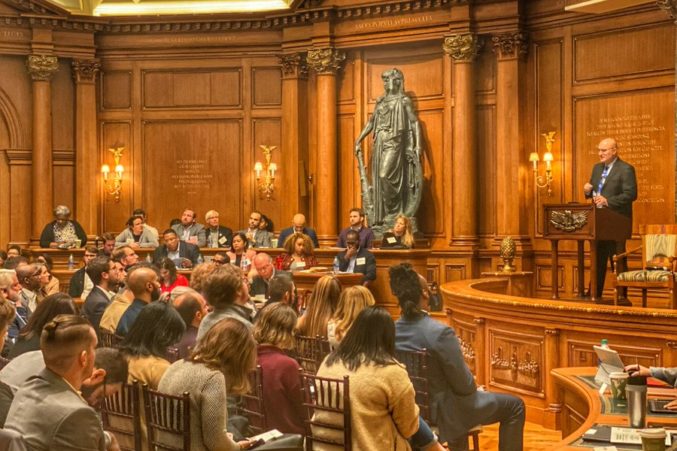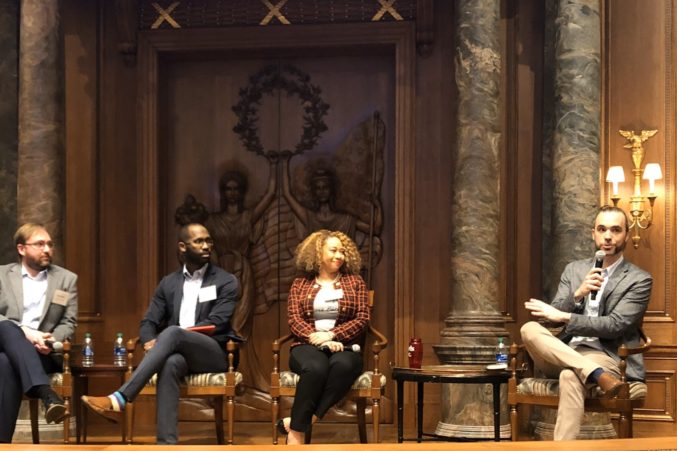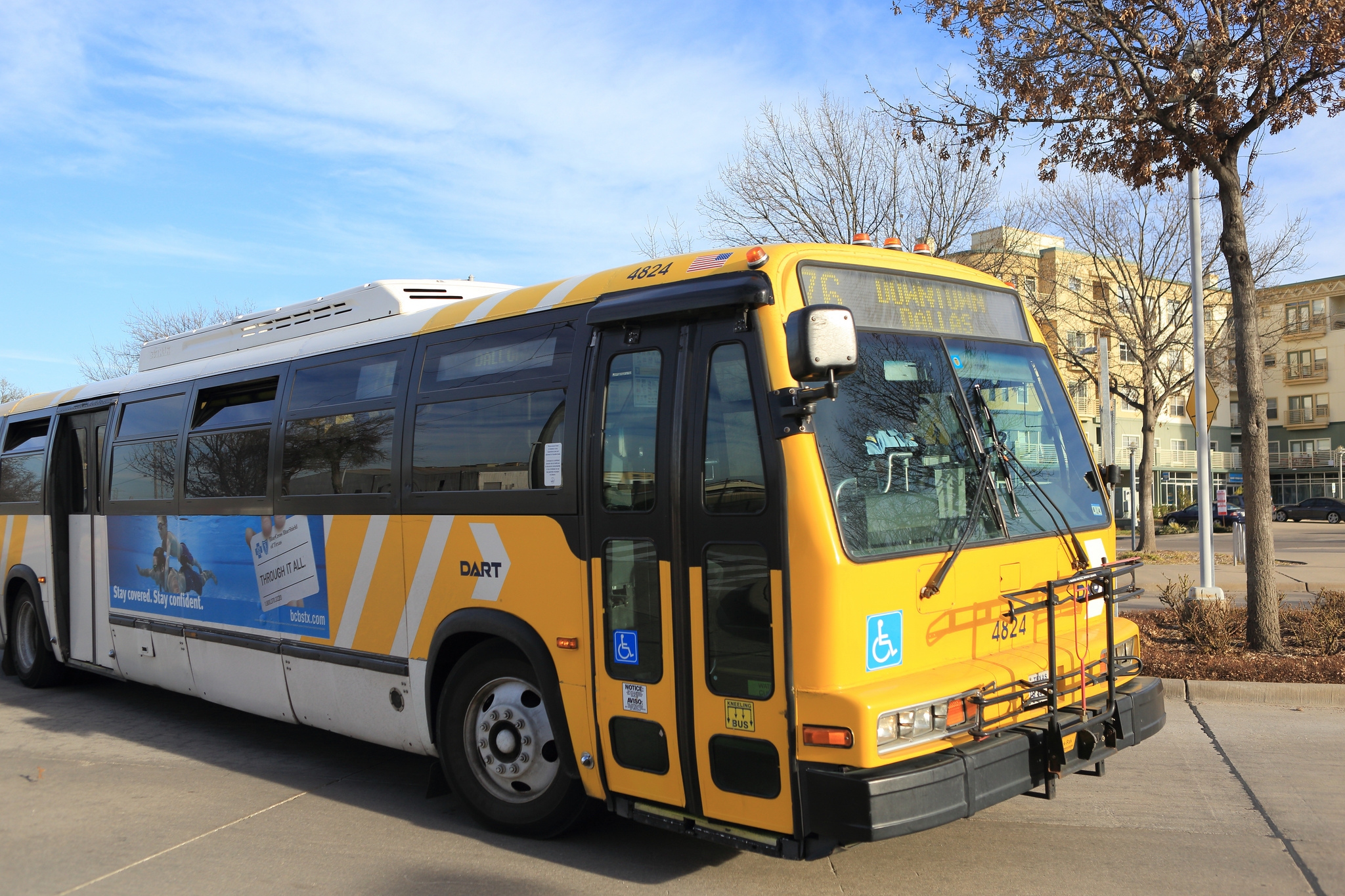The most illuminating moment of last Friday’s Death and Life of Dallas Transit symposium, which was put on by the Coalition for a New Dallas, was a simple pie chart projected on a screen by public transit consultant Jarrett Walker. Walker is the nation’s leading bus guru. He has led the network design processes for many of the most successful bus network revamps in recent years, including in Houston, Columbus, Richmond, and Auckland, New Zealand, and he’s also worked on transit with city governments in Seattle and Minneapolis. Last year, the Dallas Area Rapid Transit board hired Walker to look at its own system. On Friday, the pie chart offered our first glimpse of what that might entail.
The chart depicted the share of bus routes in DART’s current system that are designed around providing either coverage or ridership. Today, according to Walker’s analysis, DART’s bus system devotes around 43 percent of its routes toward maximizing the system’s overall coverage, and it dedicates around 56 percent toward enhancing ridership. There is also around 1 percent of routes that are duplicates—redundancies in the system.
At a glance, the chart reinforces common knowledge about DART’s system. The bus network neither excels at offering a reliable transit option nor connecting people to the places where they would like to go. But the breakdown reveals something more.
As Walker explained to the 200 or so people who had gathered in the debate hall in the Old Parkland campus, bus networks can only do one of two things. They can focus on maximizing the amount of space they cover or they can focus on providing the most reliable service. By prioritizing neither and splitting the number of routes dedicated to those two functions down the middle, DART’s current bus system reflects an inability on the part of DART’s board to decide what kind of bus system it wants.
In other words, the problem with DART is DART’s leadership, which has not decided what DART wants to be. The result is a system that tries to do a little bit of everything—to have it both ways with regard to ridership and coverage, and, therefore, it is a system that doesn’t do a good job of anything.
Can Jarrett Walker Save DART?

As Walker begins his work with DART, we need to check our expectations that the esteemed consultant will ride in on a white horse, wave a magic wand, and fix this city’s transit. Throughout his presentation, Walker emphasized that he will not design Dallas’ new bus system. Rather, he will simply strive to communicate to transit leadership and staff the costs and benefits of any changes to the system. The ultimate design will come from the decisions made by local officials. If Dallas wants quality transit, the DART board needs to overcome its historical reluctance to set clear goals for the agency. It must define what good transit is and then ask for it.
This was precisely the intent of last Friday’s symposium, to set out the terms of a broader conversation around Dallas transit. What is good transit? How do we get there? And what will it cost, both in terms of political capital and public tax dollars?
Walker’s presentation offered the most clarity on those topics. Transit is freedom, he said, because improving transit means increasing a resident’s access to options and opportunities — from jobs to shops to educational institutions to social spaces. Public transit greatly enhances individual freedom because it “is most useful when it is useful to everyone,” he said. By contrast, because cars are inefficient at moving large numbers of people and create congestion, auto-centric cities provide some mobility freedom only by simultaneously denying that freedom to others.
Walker was keen to point out that the job of providing quality public transit does not fall solely on public transit agencies. No density-poor city can rely on a regional transportation system alone to provide mobility, but must make its own investments. He cited Seattle’s decision to tax itself to generate more funding for expanded Seattle-centric bus service. Walker also emphasized that things like land use and street design—which are ultimately the city’s responsibility—are key for creating functional public transit.
“Transportation and land use describe the same thing in different languages,” he said.
Dallas Is Not Like Houston
Walker’s pie chart also illustrated DART’s limited ability to fix its own transit system. When Walker was invited to Houston to examine their bus system, he found many redundancies in the network, which allowed Houston to free up resources to improve levels of service by eliminating those duplications. DART’s system, however, doesn’t currently have many duplications. As Walker pointed out, this shows that DART’s staff of bus planners are doing a pretty good job at eliminating waste in the system, but it also means it will be difficult to find funds for improved bus service from the existing budget.
“This is not going to be as happy a story as Houston,” Walker said.
That’s not what many of the passionate transit advocates who packed the debate hall came to hear. The event was an attempt to reframe and direct this city’s transit conversation, and the packed room showed that there is a deep desire for meaningful change. After an initial presentation by TheMap.net’s Robert Mundinger, who laid out the current state of the system through a series of data analyses (look for more on that presentation on FrontBurner later this week), three panels discussed the state of the bus system, current planning around the city’s mobility and sustainability, and strategies for financing these efforts. Taken in sum, the conversations illustrated Walker’s central point about the lack of clear direction or decision-making around how Dallas would like its public transit system to function.
“The DART board has never made a decision [around the frequency vs. coverage question],” DART board member Jon-Bertrell Killen told the audience. “Faster buses will mean fewer routes, but it may also mean better shelters. But it will be a tradeoff.”
The political friction created by these necessary trade-offs has long hampered the regional transit system’s decision-making ability. DART has opted instead to balance the competing needs of urban and suburban member cities, even when it meant remaining loyal to ill-conceived transit projects simply out of a commitment to honor long-standing political promises. It was disheartening to hear DART board member Dominique Torres speak about the board’s decision to sink the agency into massive debt to fund the controversial Cotton Belt line because that light rail connection had been “written into DART’s service agreement since before I was born.”
It was another stark reminder that where Dallas and the region have failed around transit has been in leadership, and not technical expertise or institutional capacity to provide quality public transit. A later panel involving Dallas Councilman Omar Narvaez, Dallas Chief of Transportation Michael Rogers, and Dallas’ Interim Deputy Resilience Officer Genesis Gavino illustrated this point precisely in its lack of specifics. Rogers spoke to the many plans that currently touch on issues of mobility and transit—from the Downtown 360 plan to the Texas Department of Transportation’s CityMAP to the city’s own new mobility plan—and yet that very tangle of plans and agencies seems to contribute to the diluted sense of focus and divided accountability.

Good Transit Means Making Tough Choices
The mixed messaging was starkest in the final panel of the event. Steffen Fuchs, a senior partner at McKinsey & Co., spoke about the potential impact new technologies may have on the future of urban mobility. Fuchs made a vital point in noting that as the transportation sector transitions away from gasoline-powered engines toward electric vehicles, this is only going to reduce the amount of gas tax collected by state transportation agencies, vastly limiting infrastructure spending budgets.
When he was finished with his presentation, a slide lingered on the projector. It showed a city intersection with many of these new technologies coming together—autonomous cars, an un-fixed electric bus route, rideshare vehicles. Fuchs spoke about an improved ability to reroute traffic in real time to reduce congestion. Cities will need to prepare themselves for the impact these new technologies will have on their urban landscapes, he argued.
And yet, but for the novelty of cars that drive themselves or imaginary technology that might be able to instantaneously reroute traffic, Fuch’s image of the future city looked remarkably like the one we have today, reliant on single-occupant vehicles that clog streets and bus routes that cannot be relied on to provide predictable service. If anything, Fuch’s future vision looked like it was yanked directly from the playbook of the many mid-century prophets of urban futurism, people like Vincent Ponte, whose plan for downtown Dallas’ tunnels and skybridges helped provide a justification for separating pedestrians from street traffic, contributing to the forces that destroyed downtown for a generation.
As Fuchs spoke, Walker shook his head. During the Q&A, Walker’s hand shot up.
“Your slide depicts a dystopian nightmare,” Walker said. “It is a city where no one walks and where there is more traffic because it has destroyed the fixed route bus system.”
Fuchs defended his slide by saying that it was merely a representation—a compression of a number of possible future mobility technologies into a single image to depict an emerging reality that cities need to anticipate. “It’s not about being right,” Fuchs said, “but being ready.”
Setting aside the intellectual dishonesty of showing a room an image of a potential future city and only admitting its fancifulness when challenged, what I found most troubling about Fuchs’ response was its implicit assumption around the relationship between technology and mobility.
Fuchs implied that cities must adapt new technologies, regardless of their potential impact. In this way his position is not unlike the prophets of highways and sprawl, who began with the assumption that cars were an inevitable evolution of urban mobility and then set about reconfiguring the many laws and practices—from land use regulations to the ways infrastructure spending was prioritized—that allowed cars to become the dominant form of transportation. Similarly, the mere emergence of new technologies does not mean that they are good for our cities nor that our cities must adapt to them. Sometimes being ready for new technologies means recognizing that they are not right for our cities.
Walker had already addressed this in his presentation. When it comes to transit, he said, the old ideas often prove more lasting and effective. Transit, after all, isn’t rocket science. It works when there is density and when systems are reliable and predictable. It works when riders know they can get to and from their destinations with as little variation or volatility as possible. That kind of personal freedom, Walker argued, is a byproduct of technological rigidity.
The contrast between Walker’s and Fuch’s visions emphasized the fact that, ultimately, this all comes down to a choice. Do we want to adapt our streets for autonomous cars, or for greater pedestrian accessibility? Do we want to allow for flexible routes to allow for maximum coverage of DART’s service area, or do we want to create fixed routes with high levels of service that allow people to rely on the bus to move around the city? Do we want quality public transit if realizing that also means making tough decisions around land use, street design, and law enforcement?
Regardless of what Dallas wants, it will require a choice. What we learned last Friday is that Dallas’ public transit system isn’t good because its political leaders haven’t had the courage to make that choice in the past. As Walker continues his work over the coming months, let’s hope that events like Friday’s symposium are an indication that this city’s civic leadership is ready to start making the tough choices. Because creating quality public transit will require more than redesigning routes. It will require our civic leaders to face the political and economic headwinds, deal with the complicated tradeoffs, and make the case to the public that it is finally ready to improve transit in Dallas.





